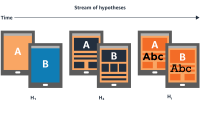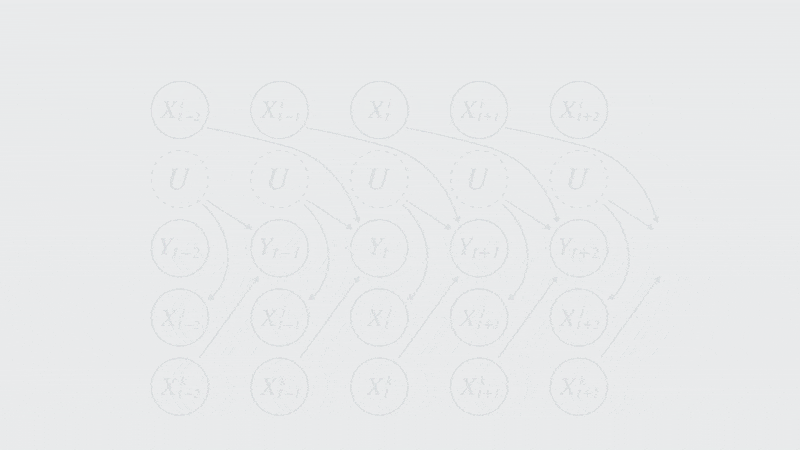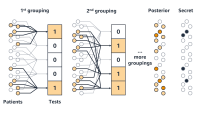Events & Conferences
The science of price experiments in the Amazon Store

The prices of products in the Amazon Store reflect a range of factors, such as demand, seasonality, and general economic trends. Pricing policies typically involve formulas that take such factors into account; newer pricing policies usually rely on machine learning models.
With the Amazon Pricing Labs, we can conduct a range of online A/B experiments to evaluate new pricing policies. Because we practice nondiscriminatory pricing — all visitors to the Amazon Store at the same time see the same prices for all products — we need to apply experimental treatments to product prices over time, rather than testing different price points simultaneously on different customers. This complicates the experimental design.
In a paper we published in the Journal of Business Economics in March and presented at the American Economics Association’s annual conference in January (AEA), we described some of the experiments we can conduct to prevent spillovers, improve precision, and control for demand trends and differences in treatment groups when evaluating new pricing policies.
The simplest type of experiment we can perform is a time-bound experiment, in which we apply a treatment to some products in a particular class, while leaving other products in the class untreated, as controls.
One potential source of noise in this type of experiment is that an external event — say, a temporary discount on the same product at a different store — can influence treatment effects. If we can define these types of events in advance, we can conduct triggered interventions, in which we time the starts of our treatment and control periods to the occurrence of the events. This can result in staggered start times for experiments on different products.
If the demand curves for the products are similar enough, and the difference in results between the treatment group and the control group are dramatic enough, time-bound and triggered experiments may be adequate. But for more precise evaluation of a pricing policy, it may be necessary to run treatment and control experiments on the same product, as would be the case with typical A/B testing. That requires a switchback experiment.
The most straightforward switchback experiment is the random-days experiments, in which, each day, each product is randomly assigned to either the control group or the treatment group. Our analyses indicate that random days can reduce the standard error of our experimental results — that is, the extent to which the statistics of our observations differ, on average, from the true statistics of the intervention — by 60%.
One of the drawbacks with any switchback experiment, however, is the risk of carryover, in which the effects of a treatment carry over from the treatment phase of the experiment to the control phase. For instance, if treatment increases a product’s sales, recommendation algorithms may recommend that product more often. That could artificially boost the product’s sales even during control periods.
We can combat carryover by instituting blackout periods during transitions to treatment and control phases. In a crossover experiment, for instance, we might apply a treatment to some products in a group, leaving the others as controls, but toss out the first week’s data for both groups. Then, after collecting enough data — say, two weeks’ worth — we remove the treatment from the former treatment group and apply it to the former control group. Once again, we throw out the first week’s data, to let the carryover effect die down.
Crossover experiments can reduce the standard error of our results measurements by 40% to 50%. That’s not quite as good as random days, but carryover effects are mitigated.
Heterogeneous panel treatment effect
The Amazon Pricing Labs also offers two more sophisticated means of evaluating pricing policies. The first of these is the heterogeneous panel treatment effect, or HPTE.
HPTE is a four-step process:
- Estimate product-level first difference from detrended data.
- Filter outliers.
- Estimate second difference from grouped products using causal forest.
- Bootstrap data to estimate noise.
Estimate product-level first difference from detrended data. In a standard difference-in-difference (DID) analysis, the first difference is the difference between the results for a single product before and after the experiment begins.
Rather than simply subtracting the results before treatment from the results after treatment, however, we analyze historical trends to predict what would have happened if products were left untreated during the treatment period. We then subtract that prediction from the observed results.
Filter outliers. In pricing experiments, there are frequently unobserved factors that can cause extreme swings in our outcome measurements. We define a cutoff point for outliers as a percentage (quantile) of the results distribution that is inversely proportional to the number of products in the data. This approach has been used previously, but we validated it in simulations.
Estimate second difference from grouped products using causal forest. In DID analysis, the second difference is the difference between the treatment and control groups’ first differences. Because we’re considering groups of heterogeneous products, we calculate the second difference only for products that have strong enough affinities with each other to make the comparison informative. Then we average the second difference across products.
To compute affinity scores, we use a variation on decision trees called causal forests. A typical decision tree is a connected acyclic graph — a tree — each of whose nodes represents a question. In our case, those questions regard product characteristics — say, “Does it require replaceable batteries?”, or “Is its width greater than three inches?”. The answer to the question determines which branch of the tree to follow.
A causal forest consists of many such trees. The questions are learned from the data, and they define the axes along which the data shows the greatest variance. Consequently, the data used to train the trees requires no labeling.
After training our causal forest, we use it to evaluate the products in our experiment. Products from the treatment and control groups that end up at the same terminal node, or leaf, of a tree are deemed similar enough that their second difference should be calculated.
Bootstrap data to estimate noise. To compute the standard error, we randomly sample products from our dataset and calculate their average treatment effect, then return them to the dataset and randomly sample again. Multiple resampling allows us to compute the variance in our outcome measures.
Spillover effect
At the Amazon Pricing Labs, we have also investigated ways to gauge the spillover effect, which occurs when treatment of one product causes a change in demand for another, similar product. This can throw off our measurements of treatment effect.
For instance, if a new pricing policy increases demand for, say, a particular kitchen chair, more customers will view that chair’s product page. Some fraction of those customers, however, may buy a different chair listed on the page’s “Discover similar items” section.
If the second chair is in the control group, its sales may be artificially inflated by the treatment of the first chair, leading to an underestimation of the treatment effect. If the second chair is in the treatment group, the inflation of its sales may lead to an overestimation of the treatment effect.
To correct for the spillover effect, we need to measure it. The first step in that process is to build a graph of products with correlated demand.
We begin with a list of products that are related to each other according to criteria such as their fine-grained classifications in the Amazon Store catalogue. For each pair of related items, we then look at a year’s worth of data to determine whether a change in the price of one affects demand for another. If those connections are strong enough, we join the products by an edge in our substitutable-items graph.
From the graph, we compute the probability that any given pair of substitutable products will find themselves included in the same experiment and which group, treatment or control, they’ll be assigned to. From those probabilities, we can use an inverse probability-weighting schema to estimate the effect of spillover on our observed outcomes.
Estimating spillover effect, however, is not as good as eliminating it. One way to do that is to treat substitutable products as a single product class and assign them to treatment or control groups en masse. This does reduce the power of our experiments, but it gives our business partners confidence that the results aren’t tainted by spillover.
To determine which products to include in each of our product classes, we use a clustering algorithm that searches the substitutable-product graph for regions of dense interconnection and severs those regions connections to the rest of the graph. In an iterative process, this partitions the graph into clusters of closely related products.
In simulations, we found that this clustering process can reduce spillover bias by 37%.
Events & Conferences
An inside look at Meta’s transition from C to Rust on mobile

Have you ever worked is legacy code? Are you curious what it takes to modernize systems at a massive scale?
Pascal Hartig is joined on the latest Meta Tech Podcast by Elaine and Buping, two software engineers working on a bold project to rewrite the decades-old C code in one of Meta’s core messaging libraries in Rust. It’s an ambitious effort that will transform a central messaging library that is shared across Messenger, Facebook, Instagram, and Meta’s AR/VR platforms.
They discuss taking on a project of this scope – even without a background in Rust, how they’re approaching it, and what it means to optimize for ‘developer happiness.’
Download or listen to the episode below:
You can also find the episode wherever you get your podcasts, including:
The Meta Tech Podcast is a podcast, brought to you by Meta, where we highlight the work Meta’s engineers are doing at every level – from low-level frameworks to end-user features.
Send us feedback on Instagram, Threads, or X.
And if you’re interested in learning more about career opportunities at Meta visit the Meta Careers page.
Events & Conferences
Amazon Research Awards recipients announced

Amazon Research Awards (ARA) provides unrestricted funds and AWS Promotional Credits to academic researchers investigating various research topics in multiple disciplines. This cycle, ARA received many excellent research proposals from across the world and today is publicly announcing 73 award recipients who represent 46 universities in 10 countries.
This announcement includes awards funded under five call for proposals during the fall 2024 cycle: AI for Information Security, Automated Reasoning, AWS AI, AWS Cryptography, and Sustainability. Proposals were reviewed for the quality of their scientific content and their potential to impact both the research community and society. Additionally, Amazon encourages the publication of research results, presentations of research at Amazon offices worldwide, and the release of related code under open-source licenses.
Recipients have access to more than 700 Amazon public datasets and can utilize AWS AI/ML services and tools through their AWS Promotional Credits. Recipients also are assigned an Amazon research contact who offers consultation and advice, along with opportunities to participate in Amazon events and training sessions.
“Automated Reasoning is an important area of research for Amazon, with potential applications across various features and applications to help improve security, reliability, and performance for our customers. Through the ARA program, we collaborate with leading academic researchers to explore challenges in this field,” said Robert Jones, senior principal scientist with the Cloud Automated Reasoning Group. “We were again impressed by the exceptional response to our Automated Reasoning call for proposals this year, receiving numerous high-quality submissions. Congratulations to the recipients! We’re excited to support their work and partner with them as they develop new science and technology in this important area.”
“At Amazon, we believe that solving the world’s toughest sustainability challenges benefits from both breakthrough scientific research and open and bold collaboration. Through programs like the Amazon Research Awards program, we aim to support academic research that could contribute to our understanding of these complex issues,” said Kommy Weldemariam, Director of Science and Innovation Sustainability. “The selected proposals represent innovative projects that we hope will help advance knowledge in this field, potentially benefiting customers, communities, and the environment.”
ARA funds proposals throughout the year in a variety of research areas. Applicants are encouraged to visit the ARA call for proposals page for more information or send an email to be notified of future open calls.
The tables below list, in alphabetical order by last name, fall 2024 cycle call-for-proposal recipients, sorted by research area.
AI for Information Security
| Recipient | University | Research title |
| Christopher Amato | Northeastern University | Multi-Agent Reinforcement Learning Cyber Defense for Securing Cloud Computing Platforms |
| Bernd Bischl | Ludwig Maximilian University of Munich | Improving Generative and Foundation Models Reliability via Uncertainty-awareness |
| Shiqing Ma | University Of Massachusetts Amherst | LLM and Domain Adaptation for Attack Detection |
| Alina Oprea | Northeastern University | Multi-Agent Reinforcement Learning Cyber Defense for Securing Cloud Computing Platforms |
| Roberto Perdisci | University of Georgia | ContextADBench: A Comprehensive Benchmark Suite for Contextual Anomaly Detection |
Automated Reasoning
| Recipient | University | Research title |
| Nada Amin | Harvard University | LLM-Augmented Semi-Automated Proofs for Interactive Verification |
| Suguman Bansal | Georgia Institute of Technology | Certified Inductive Generalization in Reinforcement Learning |
| Ioana Boureanu | University of Surrey | Phoebe+: An Automated-Reasoning Tool for Provable Privacy in Cryptographic Systems |
| Omar Haider Chowdhury | Stony Brook University | Restricter: An Automatic Tool for Authoring Amazon Cedar Access Control Policies with the Principle of Least Privilege |
| Stefan Ciobaca | Alexandru Ioan Cuza University | An Interactive Proof Mode for Dafny |
| João Ferreira | INESC-ID | Polyglot Automated Program Repair for Infrastructure as Code |
| Sicun Gao | University Of California, San Diego | Monte Carlo Trees with Conflict Models for Proof Search |
| Mirco Giacobbe | University of Birmingham | Neural Software Verification |
| Tobias Grosser | University of Cambridge | Synthesis-based Symbolic BitVector Simplification for Lean |
| Ronghui Gu | Columbia University | Scaling Formal Verification of Security Properties for Unmodified System Software |
| Alexey Ignatiev | Monash University | Huub: Next-Gen Lazy Clause Generation |
| Kenneth McMillan | University of Texas At Austin | Synthesis of Auxiliary Variables and Invariants for Distributed Protocol Verification |
| Alexandra Mendes | University of Porto | Overcoming Barriers to the Adoption of Verification-Aware Languages |
| Jason Nieh | Columbia University | Scaling Formal Verification of Security Properties for Unmodified System Software |
| Rohan Padhye | Carnegie Mellon University | Automated Synthesis and Evaluation of Property-Based Tests |
| Nadia Polikarpova | University Of California, San Diego | Discovering and Proving Critical System Properties with LLMs |
| Fortunat Rajaona | University of Surrey | Phoebe+: An Automated-Reasoning Tool for Provable Privacy in Cryptographic Systems |
| Subhajit Roy | Indian Institute of Technology Kanpur | Theorem Proving Modulo LLM |
| Gagandeep Singh | University of Illinois At Urbana–Champaign | Trustworthy LLM Systems using Formal Contracts |
| Scott Stoller | Stony Brook University | Restricter: An Automatic Tool for Authoring Amazon Cedar Access Control Policies with the Principle of Least Privilege |
| Peter Stuckey | Monash University | Huub: Next-Gen Lazy Clause Generation |
| Yulei Sui | University of New South Wales | Path-Sensitive Typestate Analysis through Sparse Abstract Execution |
| Nikos Vasilakis | Brown University | Semantics-Driven Static Analysis for the Unix/Linux Shell |
| Ping Wang | Stevens Institute of Technology | Leveraging Large Language Models for Reasoning Augmented Searching on Domain-specific NoSQL Database |
| John Wawrzynek | University of California, Berkeley | GPU-Accelerated High-Throughput SAT Sampling |
AWS AI
| Recipient | University | Research title |
| Panagiotis Adamopoulos | Emory University | Generative AI solutions for The Spillover Effect of Fraudulent Reviews on Product Recommendations |
| Vikram Adve | University of Illinois at Urbana–Champaign | Fellini: Differentiable ML Compiler for Full-Graph Optimization for LLM Models |
| Frances Arnold | California Institute of Technology | Closed-loop Generative Machine Learning for De Novo Enzyme Discovery and Optimization |
| Yonatan Bisk | Carnegie Mellon University | Useful, Safe, and Robust Multiturn Interactions with LLMs |
| Shiyu Chang | University of California, Santa Barbara | Cut the Crap: Advancing the Efficient Communication of Multi-Agent Systems via Spatial-Temporal Topology Design and KV Cache Sharing |
| Yuxin Chen | University of Pennsylvania | Provable Acceleration of Diffusion Models for Modern Generative AI |
| Tianlong Chen | University of North Carolina at Chapel Hill | Cut the Crap: Advancing the Efficient Communication of Multi-Agent Systems via Spatial-Temporal Topology Design and KV Cache Sharing |
| Mingyu Ding | University of North Carolina at Chapel Hill | Aligning Long Videos and Language as Long-Horizon World Models |
| Nikhil Garg | Cornell University | Market Design for Responsible Multi-agent LLMs |
| Jessica Hullman | Northwestern University | Human-Aligned Uncertainty Quantification in High Dimensions |
| Christopher Jermaine | Rice University | Fast, Trusted AI Using the EINSUMMABLE Compiler |
| Yunzhu Li | Columbia University | Physics-Informed Foundation Models Through Embodied Interactions |
| Pattie Maes | Massachusetts Institute of Technology | Understanding How LLM Agents Deviate from Human Choices |
| Sasa Misailovic | University of Illinois at Urbana–Champaign | Fellini: Differentiable ML Compiler for Full-Graph Optimization for LLM Models |
| Kristina Monakhova | Cornell University | Trustworthy extreme imaging for science using interpretable uncertainty quantification |
| Todd Mowry | Carnegie Mellon University | Efficient LLM Serving on Trainium via Kernel Generation |
| Min-hwan Oh | Seoul National University | Mutually Beneficial Interplay Between Selection Fairness and Context Diversity in Contextual Bandits |
| Patrick Rebeschini | University of Oxford | Optimal Regularization for LLM Alignment |
| Jose Renau | University of California, Santa Cruz | Verification Constrained Hardware Optimization using Intelligent Design Agentic Programming |
| Vilma Todri | Emory University | Generative AI solutions for The Spillover Effect of Fraudulent Reviews on Product Recommendations |
| Aravindan Vijayaraghavan | Northwestern University | Human-Aligned Uncertainty Quantification in High Dimensions |
| Wei Yang | University of Texas at Dallas | Optimizing RISC-V Compilers with RISC-LLM and Syntax Parsing |
| Huaxiu Yao | University of North Carolina at Chapel Hill | Aligning Long Videos and Language as Long-Horizon World Models |
| Amy Zhang | University of Washington | Tools for Governing AI Agent Autonomy |
| Ruqi Zhang | Purdue University | Efficient Test-time Alignment for Large Language Models and Large Multimodal Models |
| Zheng Zhang | Rutgers University-New Brunswick | AlphaQC: An AI-powered Quantum Circuit Optimizer and Denoiser |
AWS Cryptography
| Recipient | University | Research title |
| Alexandra Boldyreva | Georgia Institute of Technology | Quantifying Information Leakage in Searchable Encryption Protocols |
| Maria Eichlseder | Graz University of Technology, Austria | SALAD – Systematic Analysis of Lightweight Ascon-based Designs |
| Venkatesan Guruswami | University of California, Berkeley | Obfuscation, Proof Systems, and Secure Computation: A Research Program on Cryptography at the Simons Institute for the Theory of Computing |
| Joseph Jaeger | Georgia Institute of Technology | Analyzing Chat Encryption for Group Messaging |
| Aayush Jain | Carnegie Mellon | Large Scale Multiparty Silent Preprocessing for MPC from LPN |
| Huijia Lin | University of Washington | Large Scale Multiparty Silent Preprocessing for MPC from LPN |
| Hamed Nemati | KTH Royal Institute of Technology | Trustworthy Automatic Verification of Side-Channel Countermeasures for Binary Cryptographic Programs using the HoIBA libary |
| Karl Palmskog | KTH Royal Institute of Technology | Trustworthy Automatic Verification of Side-Channel Countermeasures for Binary Cryptographic Programs using the HoIBA libary |
| Chris Peikert | University of Michigan, Ann Arbor | Practical Third-Generation FHE and Bootstrapping |
| Dimitrios Skarlatos | Carnegie Mellon University | Scale-Out FHE LLMs on GPUs |
| Vinod Vaikuntanathan | Massachusetts Institute of Technology | Can Quantum Computers (Really) Factor? |
| Daniel Wichs | Northeastern University | Obfuscation, Proof Systems, and Secure Computation: A Research Program on Cryptography at the Simons Institute for the Theory of Computing |
| David Wu | University Of Texas At Austin | Fast Private Information Retrieval and More using Homomorphic Encryption |
Sustainability
| Recipient | University | Research title |
| Meeyoung Cha | Max Planck Institute | Forest-Blossom (Flossom): A New Framework for Sustaining Forest Biodiversity Through Outcome-Driven Remote Sensing Monitoring |
| Jingrui He | University of Illinois at Urbana–Champaign | Foundation Model Enabled Earth’s Ecosystem Monitoring |
| Pedro Lopes | University of Chicago | AI-powered Tools that Enable Engineers to Make & Re-make Sustainable Hardware |
| Cheng Yaw Low | Max Planck Institute | Forest-Blossom (Flossom): A New Framework for Sustaining Forest Biodiversity Through Outcome-Driven Remote Sensing Monitoring |
Events & Conferences
Independent evaluations demonstrate Nova Premier’s safety

AI safety is a priority at Amazon. Our investment in safe, transparent, and responsible AI (RAI) includes collaboration with the global community and policymakers. We are members of and collaborate with organizations such as the Frontier Model Forum, the Partnership on AI, and other forums organized by government agencies such as the National Institute of Standards and Technology (NIST). Consistent with Amazon’s endorsement of the Korea Frontier AI Safety Commitments, we published our Frontier Model Safety Framework earlier this year.
During the development of the Nova Premier model, we conducted a comprehensive evaluation to assess its performance and safety. This included testing on both internal and public benchmarks and internal/automated and third-party red-teaming exercises. Once the final model was ready, we prioritized obtaining unbiased, third-party evaluations of the model’s robustness against RAI controls. In this post, we outline the key findings from these evaluations, demonstrating the strength of our testing approach and Amazon Premier’s standing as a safe model. Specifically, we cover our evaluations with two third-party evaluators: PRISM AI and ActiveFence.
Evaluation of Nova Premier against PRISM AI
PRISM Eval’s Behavior Elicitation Tool (BET) dynamically and systematically stress-tests AI models’ safety guardrails. The methodology focuses on measuring how many adversarial attempts (steps) it takes to get a model to generate harmful content across several key risk dimensions. The central metric is “steps to elicit” — the number of increasingly sophisticated prompting attempts required before a model generates an inappropriate response. A higher number of steps indicates stronger safety measures, as the model is more resistant to manipulation. The PRISM risk dimensions (inspired by the MLCommons AI Safety Benchmarks) include CBRNE weapons, violent crimes, non-violent crimes, defamation, and hate, amongst several others.
Using the BET Eval tool and its V1.0 metric, which is tailored toward non-reasoning models, we compared the recently released Nova models (Pro and Premier) to the latest models in the same class: Claude (3.5 v2 and 3.7 non-reasoning) and Llama4 Maverick, all available through Amazon Bedrock. PRISM BET conducts black-box evaluations (where model developers don’t have access to the test prompts) of models integrated with their API. The evaluation conducted with BET Eval MAX, PRISM’s most comprehensive/aggressive testing suite, revealed significant variations in safety against malicious instructions. Nova models demonstrated superior overall safety performance, with an average of 43 steps for Premier and 52 steps for Pro, compared to 37.7 for Claude 3.5 v2 and fewer than 12 steps for other models in the comparison set (namely, 9.9 for Claude3.7, 11.5 for Claude 3.7 thinking, and 6.5 for Maverick). This higher step count suggests that on average, Nova’s safety guardrails are more sophisticated and harder to circumvent through adversarial prompting. The figure below presents the number of steps per harm category evaluated through BET Eval MAX.
The PRISM evaluation provides valuable insights into the relative safety of different Amazon Bedrock models. Nova’s strong performance, particularly in hate speech and defamation resistance, represents meaningful progress in AI safety. However, the results also highlight the ongoing challenge of building truly robust safety measures into AI systems. As the field continues to evolve, frameworks like BET will play an increasingly important role in benchmarking and improving AI safety. As a part of this collaboration Nicolas Miailhe, CEO of PRISM Eval, said, “It’s incredibly rewarding for us to see Nova outperforming strong baselines using the BET Eval MAX; our aim is to build a long-term partnership toward safer-by-design models and to make BET available to various model providers.” Organizations deploying AI systems should carefully consider these safety metrics when selecting models for their applications.
Manual red teaming with ActiveFence
The AI safety & security company ActiveFence benchmarked Nova Premier on Bedrock on prompts distributed across Amazon’s eight core RAI categories. ActiveFence also evaluated Claude 3.7 (non-reasoning mode) and GPT 4.1 API on the same set. The flag rate on Nova Premier was lower than that on the other two models, indicating that Nova Premier is the safest of the three.
| Model | 3P Flag Rate [↓ is better] |
| Nova Premier | 12.0% |
| Sonnet 3.7 (non-reasoning) | 20.6% |
| GPT4.1 API | 22.4% |
“Our role is to think like an adversary but act in service of safety,” said Guy Paltieli from ActiveFence. “By conducting a blind stress test of Nova Premier under realistic threat scenarios, we helped evaluate its security posture in support of Amazon’s broader responsible-AI goals, ensuring the model could be deployed with greater confidence.”
These evaluations conducted with PRISM and ActiveFence give us confidence in the strength of our guardrails and our ability to protect our customers’ safety when they use our models. While these evaluations demonstrate strong safety performance, we recognize that AI safety is an ongoing challenge requiring continuous improvement. These assessments represent a point-in-time snapshot, and we remain committed to regular testing and enhancement of our safety measures. No AI system can guarantee perfect safety in all scenarios, which is why we maintain monitoring and response systems after deployment.
Acknowledgments: Vincent Ponzo, Elyssa Vincent
-
Funding & Business6 days ago
Kayak and Expedia race to build AI travel agents that turn social posts into itineraries
-
Jobs & Careers6 days ago
Mumbai-based Perplexity Alternative Has 60k+ Users Without Funding
-
Mergers & Acquisitions6 days ago
Donald Trump suggests US government review subsidies to Elon Musk’s companies
-
Funding & Business6 days ago
Rethinking Venture Capital’s Talent Pipeline
-
Jobs & Careers6 days ago
Why Agentic AI Isn’t Pure Hype (And What Skeptics Aren’t Seeing Yet)
-
Funding & Business3 days ago
Sakana AI’s TreeQuest: Deploy multi-model teams that outperform individual LLMs by 30%
-
Funding & Business6 days ago
From chatbots to collaborators: How AI agents are reshaping enterprise work
-
Jobs & Careers6 days ago
Telangana Launches TGDeX—India’s First State‑Led AI Public Infrastructure
-
Jobs & Careers3 days ago
Ilya Sutskever Takes Over as CEO of Safe Superintelligence After Daniel Gross’s Exit
-
Funding & Business3 days ago
Dust hits $6M ARR helping enterprises build AI agents that actually do stuff instead of just talking






































